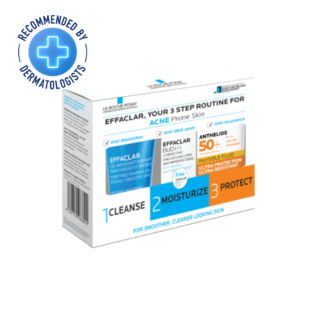Starting a skincare routine can feel overwhelming with the endless options and new trends popping up. But skincare doesn’t have to be complicated! A simple, consistent routine with effective products can make all the difference in achieving healthy, glowing skin.
This guide will break down the basics of skincare for beginners, helping you understand what your skin needs and how to care for it. Whether you’re struggling with breakouts, dryness, or just want to keep your skin looking its best, this guide is for you.
.
Step 1: Identify Your Skin Type
The first step to any successful skincare routine is knowing your skin type. Here’s a quick guide to help you figure it out:
1.Normal Skin: Your skin feels balanced—not too oily, not too dry—and rarely experiences breakouts.
2.Oily Skin: You have excess oil, especially in the T-zone (forehead, nose, chin). You may notice larger pores and are prone to acne or blackheads.
3.Dry Skin: Your skin feels tight, may look flaky, and lacks natural oils. Dry skin can also feel rough or irritated.
4.Combination Skin: You have both oily and dry areas, typically an oily T-zone with drier cheeks.
5.Sensitive Skin: Your skin reacts easily to products, causing redness, itching, or irritation.
Knowing your skin type will help you choose products that address your specific needs without causing irritation.
.
Step 2: Build a Simple Skincare Routine
Once you know your skin type, you can create a routine with products suited to your needs. For beginners, stick to a basic routine with three main steps: cleanse, moisturize, and protect. Let’s break it down:
1. Cleanser (Morning and Night)
Cleansing removes dirt, oil, and impurities from your skin, preventing clogged pores and breakouts. Look for a gentle cleanser that suits your skin type:
●For oily skin: Gel-based or foaming cleansers can help remove excess oil without stripping the skin.
●For dry skin: Choose a cream or hydrating cleanser to add moisture as it cleanses.
●For sensitive skin: Use a fragrance-free, gentle cleanser to avoid irritation.
How to Use: Wet your face, apply a small amount of cleanser, and gently massage it into your skin. Rinse with lukewarm water and pat dry with a clean towel.
2. Moisturizer (Morning and Night)
Moisturizing helps keep your skin hydrated and soft. Even if you have oily skin, you still need to moisturize—just choose a lightweight, oil-free formula.
●For dry skin: Look for a rich, hydrating cream to lock in moisture.
●For oily or combination skin: Go for a lighter, gel-based moisturizer to avoid clogging pores.
●For sensitive skin: Opt for fragrance-free, calming moisturizers that won’t irritate.
How to Use: After cleansing, apply a small amount of moisturizer to your face and neck, and gently massage it in.
3. Sunscreen (Morning)
Sunscreen is the most crucial step in your daytime skincare routine. Sun exposure can lead to premature aging, dark spots, and an increased risk of skin cancer. Use a broad-spectrum SPF 30 or higher every day, even when it’s cloudy or rainy.
●For oily skin: Look for a mattifying or oil-free sunscreen.
●For dry skin: Choose a hydrating sunscreen with added moisturizers.
●For sensitive skin: Mineral sunscreens with zinc oxide or titanium dioxide are usually gentler on sensitive skin.
How to Use: After moisturizing, apply a generous amount of sunscreen to your face and neck. Reapply every two hours if you’re outside for extended periods.
.
Optional Steps: Add-On Products
Once you’ve established a basic routine and feel comfortable with it, you can gradually add other products to address specific skin concerns. Here are some common add-ons:
1.Exfoliator (1–2 times per week): Exfoliating removes dead skin cells, leaving your skin smoother and more radiant. Chemical exfoliants like AHAs (glycolic acid) and BHAs (salicylic acid) are gentler on the skin than physical scrubs. Start slowly to avoid irritation.
2.Toner: A toner can help balance your skin’s pH and remove any leftover impurities after cleansing. If you have oily or acne-prone skin, look for a toner with salicylic acid. For dry or sensitive skin, choose a hydrating, alcohol-free toner.
3.Serum: Serums contain high concentrations of active ingredients to target specific skin issues. For example:
○Vitamin C for brightening and evening out skin tone.
○Hyaluronic acid for hydration.
○Niacinamide for reducing oil and calming redness.
○Retinol for anti-aging (best used at night and only if you feel ready).
4.Face Mask (Once a week): Face masks can give your skin an extra boost. Use clay masks for oily skin to control excess oil or hydrating masks for dry skin to lock in moisture.
.
Skincare Tips for Beginners
Here are some additional tips to help you make the most of your skincare routine:
1.Start Simple: You don’t need a 10-step routine to see results. Stick with the basics first, then add products slowly as needed.
2.Introduce New Products Gradually: When adding a new product, test it on a small patch of skin first to ensure you don’t have a reaction.
3.Be Consistent: Consistency is key to achieving results. Stick to your routine every morning and night for the best outcomes.
4.Be Patient: Skincare is a journey, not an overnight fix. Give your products at least 4–6 weeks to show results.
5.Remove Makeup Before Bed: Sleeping with makeup can clog your pores and lead to breakouts. Use a makeup remover or a gentle cleanser to remove makeup before your nighttime routine.
6.Stay Hydrated and Eat a Balanced Diet: Healthy skin starts from within. Drink plenty of water, eat nutrient-rich foods, and avoid excessive sugar and processed foods.
.
Common Skincare Mistakes to Avoid
Even with the best intentions, beginners sometimes make mistakes that can hinder their progress. Here are a few common ones:
1.Over-Exfoliating: Exfoliating too often can irritate and damage your skin. Stick to once or twice a week and be gentle.
2.Skipping Sunscreen: Sunscreen is essential every day, even if you’re indoors. UV rays can penetrate windows, causing skin damage over time.
3.Trying Too Many Products at Once: Avoid overwhelming your skin by introducing one new product at a time. This also helps you identify any reactions.
4.Picking at Your Skin: Picking pimples or touching your face often can spread bacteria and cause breakouts. Keep your hands off your face as much as possible.
5.Not Removing Makeup Properly: Always take off your makeup before bed. Makeup can trap dirt and oil, leading to clogged pores and breakouts.
.
Final Thoughts
Starting a skincare routine doesn’t have to be complicated. By following these steps and keeping things simple, you can build a routine that fits your lifestyle and helps you achieve beautiful, healthy skin. Remember, consistency and patience are essential—give your skin time to adjust, and the results will come.
With a clear routine and the right products, you’ll be on your way to glowing, radiant skin!
.









